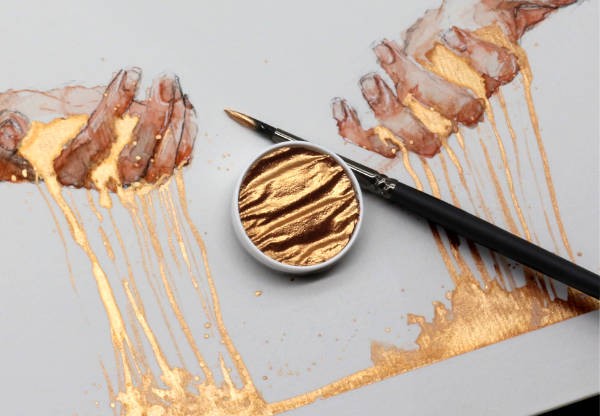History of Watercolors: From Ancient Beginnings to Modern Mastery
Watercolors have a rich and fascinating history that spans centuries and continents. These versatile and vibrant paints have captured the imaginations of artists and enthusiasts alike. In this article, we will delve into the intriguing journey of watercolors, from their ancient origins to their contemporary prominence. Let's explore how this captivating medium has evolved, adapted, and become a cherished part of artistic expression.
Table of Contents
- Introduction
- Early Beginnings: Origins of Watercolor Painting
- Renaissance Resurgence: Watercolors in the 15th to 17th Centuries
- Landscape and Enlightenment: 18th-Century Watercolor Traditions
- Evolution of Techniques: 19th-Century Advancements
- Emergence of Modernism: 20th-Century Watercolor Innovations
- Contemporary Expressions: Watercolors in the 21st Century
- The Role of Watercolors in Different Cultures
- Famous Watercolor Artists Throughout History
- Materials and Techniques: Unveiling the Magic of Watercolors
- Preserving and Caring for Watercolor Artworks
- Exploring the Allure of Transparent vs. Opaque Watercolors
- Watercolors in the Digital Age: Bridging Tradition and Technology
- Inspiring Creativity: Tips for Aspiring Watercolor Artists
- Conclusion
Early Beginnings: Origins of Watercolor Painting
Watercolors have ancient roots, with evidence of their usage dating back to early civilizations such as Ancient Egypt and China. In China, watercolor techniques were documented as far back as the 4th century, where they were employed for illustrating scrolls and depicting landscapes. Similarly, Ancient Egyptian artists used water-based pigments to decorate papyrus scrolls and create vibrant illustrations.
Renaissance Resurgence: Watercolors in the 15th to 17th Centuries
The Renaissance period witnessed a renewed interest in watercolor techniques, as artists began to explore new avenues of creativity. Notable artists like Albrecht Dürer used watercolors to experiment with color blending and layering, laying the foundation for future advancements.
Landscape and Enlightenment: 18th-Century Watercolor Traditions
The 18th century saw watercolors gaining popularity in the realm of landscape painting. Artists embraced the medium to capture the beauty of nature with delicate washes and subtle hues. This era also marked the rise of watercolor societies, where enthusiasts and professionals came together to share their knowledge and foster the growth of the art form.
Evolution of Techniques: 19th-Century Advancements
The 19th century brought significant innovations to watercolor techniques. Artists like J.M.W. Turner pushed the boundaries of the medium, experimenting with texture, light, and atmosphere. The portability of watercolor paints also made them a favorite among travelers and explorers, enabling them to document their journeys with exquisite precision.
Emergence of Modernism: 20th-Century Watercolor Innovations
As modernism took hold, watercolor artists embraced experimentation and abstraction. Visionaries like Wassily Kandinsky and Paul Klee incorporated watercolors into their avant-garde works, blurring the lines between representation and imagination. The 20th century also witnessed the integration of watercolors into commercial illustrations, advertisements, and book illustrations.
Contemporary Expressions: Watercolors in the 21st Century
In the 21st century, watercolors continue to evolve and adapt to contemporary artistic trends. Artists combine traditional techniques with digital tools, leading to a fusion of traditional and modern aesthetics. The accessibility of materials and online platforms has also democratized watercolor art, allowing artists to share their creations with a global audience.
The Role of Watercolors in Different Cultures
Watercolors have played a significant role in various cultures around the world. From Japanese Sumi-e paintings to Indian miniature artworks, the medium has been embraced for its versatility and expressive qualities. Different cultures have developed unique approaches to using watercolors, showcasing the diverse range of artistic possibilities.
Famous Watercolor Artists Throughout History
Throughout history, numerous artists have left an indelible mark on the world of watercolors. From the delicate botanical illustrations of Maria Sibylla Merian to the atmospheric landscapes of Winslow Homer, these artists have demonstrated the captivating beauty and emotive power of the medium.
Materials and Techniques: Unveiling the Magic of Watercolors
Watercolor painting involves a delicate interplay of pigments and water on paper. The choice of paper, pigments, brushes, and techniques all contribute to the final outcome of the artwork. Artists carefully balance transparency, layering, and color mixing to achieve stunning effects that capture light and mood.
Preserving and Caring for Watercolor Artworks
Preserving watercolor artworks requires special attention due to the delicate nature of the medium. Protecting paintings from exposure to light, humidity, and environmental pollutants is crucial for ensuring their longevity. Proper framing and archival materials help safeguard these precious creations for generations to come.
Exploring the Allure of Transparent vs. Opaque Watercolors
Watercolor paints come in both transparent and opaque varieties, each offering unique characteristics. Transparent watercolors allow light to pass through the paint layers, creating luminous effects, while opaque watercolors offer more coverage and can be layered on the paper. Artists often choose between these options based on their desired visual outcome.
Watercolors in the Digital Age: Bridging Tradition and Technology
The digital age has brought new possibilities for watercolor artists. Digital tools allow for experimentation without the limitations of physical materials. Artists can create digital sketches, explore color palettes, and even mimic traditional watercolor effects using digital platforms, fostering a dynamic relationship between tradition and innovation.
Inspiring Creativity: Tips for Aspiring Watercolor Artists
For those venturing into the world of watercolors, here are some tips to ignite your creative journey:
- Start with a limited color palette to understand color mixing.
- Experiment with different types of paper to discover your preferred texture.
- Embrace the unpredictability of watercolors; let accidents guide your art.
- Practice layering and glazing to create depth and luminosity.
- Study the works of master watercolor artists for inspiration and guidance.
Conclusion
The history of watercolors is a testament to the enduring allure of this versatile medium. From ancient origins to modern innovations, watercolors have transcended time and culture, leaving their mark on the art world. Whether used to capture the nuances of nature or to express abstract emotions, watercolors continue to inspire and captivate artists and enthusiasts alike.


